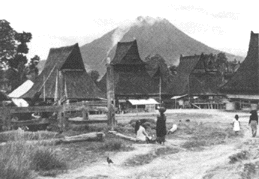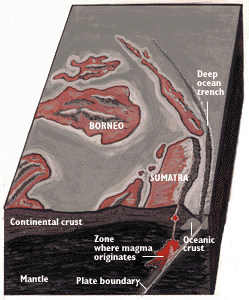Volcanoes are generally found where tectonic plates are diverging or converging. A mid-oceanic ridge, for example the Mid-Atlantic Ridge, has examples of volcanoes caused by divergent tectonic plates pulling apart; the Pacific Ring of Fire has examples of volcanoes caused byconvergent tectonic plates coming together. By contrast, volcanoes are usually not created where two tectonic plates slide past one another. Volcanoes can also form where there is stretching and thinning of the Earth's crust in the interiors of plates, e.g., in the East African Rift, the Wells Gray-Clearwater volcanic field and the Rio Grande Rift in North America. This type of volcanism falls under the umbrella of "Plate hypothesis" volcanism.
Intraplate volcanism has also been postulated to be caused by mantle plumes. These so-called "hotspots", for example Hawaii, are postulated to arise from upwelling diapirs from the core-mantle boundary, 3,000 km deep in the Earth.
Volcano Environments.
There are more than 500 active volcanoes (those that have erupted at least once within recorded history) in the world--50 of which are in the United States (Hawaii, Alaska, Washington, Oregon, and California)--although many more are hidden under the seas. Most active volcanoes are strung like beads along, or near, the margins of the continents, and more than half en circle the Pacific Ocean as a "Ring of Fire."
Many volcanoes are in and around the Mediterranean Sea. Mount Etna in Sicily is the largest and hiqhest of these mountains. Italy's Vesuvius is the only active volcano on the European mainland. Near the island of Vulcano, the volcano Stromboli has been in a state of nearly continuous, mild eruption since early Roman times. At night, sailors in the Mediterranean can see the glow from the fiery molten material that is hurled into the air. Very appropriately, Stromboli has been called "the lighthouse of the Mediterranean.
Some volcanoes crown island areas lying near the continents, and others form chains of islands in the deep ocean basins. Volcanoes tend to cluster along narrow mountainous belts where folding and fracturing of the rocks provide channelways to the surface for the escape of magma. Significantly, major earthquakes also occur along these belts, indicating that volcanism and seismic activity are often closely related, responding to the same dynamic Earth forces.
In a typical "island-arc" environment, volcanoes lie along the crest of an arcuate, crustal ridge bounded on its convex side by a deep oceanic trench. The granite or granitelike layer of the continental crust extends beneath the ridge to the vicinity of the trench. Basaltic magmas, generated in the mantle beneath the ridge, rise along fractures through the granitic layer. These magmas commonly will be modified or changed in composition during passage through the granitic layer and erupt on the surface to form volcanoes built largely of nonbasaltic rocks.
 |  |
In a typical "oceanic" environment, volcanoes are alined along the crest of a broad ridge that marks an active fracture system in the oceanic crust. Basaltic magmas, generated in the upper mantle beneath the ridge, rise along fractures through the basaltic layer. Because the granitic crustal layer is absent, the magmas are not appreciably modified or changed in composition and they erupt on the surface to form basaltic volcanoes.
In the typical "continental" environment, volcanoes are located unstable, mountainous belts that have thick roots of granite or granitelike rock. Magmas, generated near the base of the mountain root, rise slowly or intermittently along fractures in the crust. During passage through the granitic layer, magmas are commonly modified or changed in composition and erupt on the surface to form volcanoes constructed of nonbasaltic rocks.
Source: ^ "Volcano Environments". U.S. Geological Survey.

No comments:
Post a Comment